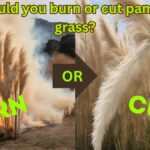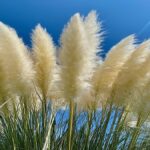Do Cows Eat Pampas Grass? Pampas Grass, a tall, feathery plant native to South America, is known for its ornamental value in landscaping. But does it also have a place in a cow’s diet? We’ll explore this question from various angles, considering factors like the nutritional value of Pampas Grass, potential health risks, and the practicality of feeding it to cows.
What is Pampas Grass?
Pampas Grass, scientifically known as Cortaderia selloana, is a species of flowering plant in the Poaceae family. It is native to southern South America, including the Pampas region, which is how it got its name. This large, ornamental grass is known for its unmistakable feathery white plumes.
Description and Characteristics of Pampas Grass
Pampas Grass is characterized by its tall, reed-like appearance and feathery plumes, which can be either white or pink. It grows in a clumping habit and can reach a height of 8 to 12 feet, with clumps getting as wide as 6 feet. The silver-white plumes, sometimes tinted pink, are the flowers or inflorescences of this grass plant. The fluffy dense panicles reach 1 to 4 feet long, increasing the overall height of the pampas grass clump.
The plant is hardy in U.S. Department of Agriculture plant hardiness zones 7 through 10. It thrives in hot climates and can withstand both heat and high humidity. On the other hand, these hardy grasses can also withstand cold winters and even some snow.
Common Uses of Pampas Grass
Pampas Grass is admired for both its beauty and practical uses. It is one of the most frequently planted ornamental grass varieties worldwide. In some regions, the plumes are used for decorative purposes, such as floral arrangements or home decor. Additionally, the leaves can be woven to create baskets, mats, or even roof thatching.
Pampas Grass is also good for erosion control and is often used to stabilize stream banks and coastal landscapes. It is considered an ideal plant to use for a privacy screen or camouflaging things like HVAC units and undesirable views. However, it is considered invasive in some areas such as California, Hawaii, Texas, Oregon, and Washington, and it’s not recommended for planting in those regions.
Nutritional Content of Pampas Grass
Pampas Grass, while not a common feed for livestock, does contain some nutritional value. It is a low-calorie source of fiber and protein. Additionally, it is rich in vitamins and minerals, including vitamin A, vitamin C, calcium, and iron. Pampas Grass also contains minerals like phosphorus and calcium.
Comparison with Other Common Grasses in Cow Diets
When compared to other common grasses in cow diets, Pampas Grass is not typically a preferred choice. Cows, given a choice, would likely choose more palatable forage grasses over Pampas Grass. This is due to the sharp and tough nature of Pampas Grass leaves, which can make it difficult for cows to consume.
It’s also worth noting that some types of grass can be harmful to cows if they contain toxic compounds. Examples include tall fescue infected with a fungal endophyte, which can cause health issues in cattle, and Johnsongrass, which can be toxic if consumed in large quantities.
Cows’ Interaction with Pampas Grass
Observations from TomKat Ranch have shown that cattle can indeed graze on Pampas Grass. The cattle were seen enthusiastically grazing on Pampas Grass, which is a large, invasive species in the area. This observation suggests that cattle can be used as a tool to manage the spread of Pampas Grass.
Observations on Cows Grazing on Pampas Grass
While cows can eat Pampas Grass, they do not prefer it as a primary food source. The leaves of Pampas Grass are sharp and tough, which makes it difficult for cows to consume. Given a choice, cows would likely choose more palatable forage grasses over Pampas Grass.
Behavioral Patterns and Preferences
Cattle have specific grazing behaviors and diet selection processes. They use a hierarchical decision-making process to make diet selection decisions. Cattle also use foraging strategies to determine where and when they will graze each day. Understanding these behaviors and preferences can help managers control cattle grazing behavior to obtain desired outcomes for both land management and animal performance.
In terms of time of day, cattle prefer to do most of their grazing in the early morning or late in the day when it’s cool. During the heat of the day, they rest in a shady area to chew the cud and then head out to graze again in late afternoon.
Health Implications for Cows
Potential Benefits of Pampas Grass in Cows’ Diet
Pampas Grass, while not a common feed for livestock, does contain some nutritional value. It is a low-calorie source of fiber and protein. Additionally, it is rich in vitamins and minerals, including vitamin A, vitamin C, calcium, and iron. Pampas Grass also contains minerals like phosphorus and calcium.
Interestingly, observations from TomKat Ranch have shown that cattle can indeed graze on Pampas Grass. The cattle were seen enthusiastically grazing on Pampas Grass, which is a large, invasive species in the area. This observation suggests that cattle can be used as a tool to manage the spread of Pampas Grass.
Possible Risks or Adverse Effects
Despite its potential benefits, Pampas Grass also poses several risks. The plant’s leaves are sharp and tough, which can make it difficult for animals to consume. This could potentially limit the nutritional benefits that animals, such as cows, might receive from consuming Pampas Grass.
Pampas Grass is highly invasive outside of its natural habitat, particularly in areas where Mediterranean climates dominate. It spreads rapidly and forms dense clumps that can disrupt and alter local ecosystems. This can make it difficult to control or remove Pampas Grass once it becomes established.
Moreover, Pampas Grass can displace native plants and destroy their habitats, reducing biodiversity. It is considered invasive in some areas such as California, Hawaii, Texas, Oregon, and Washington, and it’s not recommended for planting in those regions.
Does Pampas Grass Grow Back After Cutting?
Feeding Pampas Grass to Cows
Here’s some information on feeding pampas grass to cows and monitoring their diet:
Feeding Pampas Grass to Cows
- Cows can eat pampas grass. However, they do not prefer it as a food source because the leaves are sharp and tough, making it difficult for them to consume.
- If given a choice, cows would likely choose more palatable forage grasses over pampas grass.
- The use of pampas grass is recommended under certain circumstances, such as for breeding cows after weaning or before calving.
- It is suggested that feeding this grass to beef cattle could result in cost savings in terms of hay saved.
Best Practices for Introducing Pampas Grass to Cattle
- Introduce pampas grass gradually to allow the cows’ digestive system to adjust.
- Monitor the cows’ reaction to the new feed. If they show signs of discomfort or refuse to eat the grass, it may be best to provide alternative forage.
Tips for Monitoring and Adjusting Cows’ Diet
- Regularly monitor the amount of feed consumed and observe the consistency of manure to assess the efficiency of digestion.
- Adjust the ration formulation according to the observed feed intake and digestion patterns to ensure optimal nutrient utilization.
- Regular monitoring of body condition scores, which assess the fat cover on an animal, provides valuable insights into whether your feeding program is meeting the herd’s needs.
- Adapting the diet in response to seasonal changes, such as the availability and quality of forage, ensures that nutritional requirements are consistently met.
Alternative Grass Options for Cattle
Here is some other nutritious grasses for cows and a comparative analysis of their benefits:
1. Bermudagrass
- Bermudagrass is a warm-season grass that is packed with protein for cows.
- It has the fastest growth of all warm-season grasses and excellent nutritional value both as fresh forage and hay.
- Bermudagrass is drought-tolerant, making it an optimal choice for pastures in arid or desert areas.
2. Bahiagrass
- Bahiagrass is another perennial grass that prefers wet areas and warm temperatures.
- Its nutritional value is similar to Bermudagrass.
3. Ryegrass
- Ryegrass is energy-dense compared to other grass species, making it desirable for grazing.
- It is the most commonly used grass for cattle grazing in Australia due to its high energy and protein content.
4. Fescue
- Fescue is less nutrient and energy-dense than other grasses, but it has the benefit of being resistant to drought, can withstand extreme temperatures, survives animals trodding on it, and can be planted in poor quality soil.
- Fescue is often planted alongside other grasses to create a more diverse and hard-wearing mix of grasses for foraging.
5. Alfalfa
- Although Alfalfa is not a grass, but a legume, it’s one of the most popular crops for grazing animals in the US.
- It’s more nutrient and energy-dense than any grass species, and it can be cut, dried, and stored as hay for winter.
Comparative Analysis
- Each grass species is best suited to different climates and soil types, and each has different nutrient densities and general care requirements.
- Grasses are generally moderate to low in crude protein (CP) compared to alfalfa and most co-products contain a significant amount of CP.
- The nutritional value of these grasses diminishes when fed as hay, but they are still more nutritious than other grass types.
- The choice of grass for cattle should be based on the climate in your area.
- Hot and humid areas with annual temperatures between 80° and 95° F are best suited for warm-season grasses.
- Cool-season varieties are best suited for zones with temperatures between 60° and 70° F, such as the Pacific Northwest and the North-eastern regions of the United States.
Conclusion
In conclusion, while cows can indeed eat pampas grass, it is not their preferred choice due to the sharp and tough nature of the leaves. However, under certain circumstances, such as for breeding cows after weaning or before calving, the use of pampas grass could result in cost savings in terms of hay saved. It’s important to introduce this new feed gradually and monitor the cows’ reaction to it. If they show signs of discomfort or refuse to eat the grass, it may be best to provide alternative forage.
There are also other nutritious grasses available for cows such as Bermudagrass, Bahiagrass, Ryegrass, Fescue, and Alfalfa. Each of these has its own benefits and is best suited to different climates and soil types.
FAQs
Here are some Frequently Asked Questions (FAQs):
Do cows prefer to eat pampas grass over other types of grass?
While cows can eat pampas grass, it is not their preferred choice due to the sharp and tough nature of the leaves. They would likely choose more palatable forage grasses over pampas grass.
What are the benefits of feeding pampas grass to cows?
The use of pampas grass is recommended under certain circumstances, such as for breeding cows after weaning or before calving. Feeding this grass to beef cattle could result in cost savings in terms of hay saved.
How should pampas grass be introduced to a cow’s diet?
It’s important to introduce pampas grass gradually to allow the cows’ digestive system to adjust. Monitor the cows’ reaction to the new feed. If they show signs of discomfort or refuse to eat the grass, it may be best to provide alternative forage.
What are some alternative nutritious grasses for cows?
There are several nutritious grasses available for cows such as Bermudagrass, Bahiagrass, Ryegrass, Fescue, and Alfalfa. Each of these has its own benefits and is best suited to different climates and soil types.


